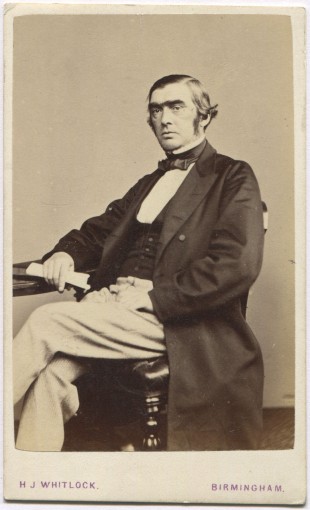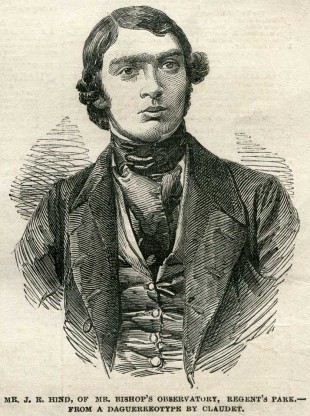…where east meets west
- Home
- Brief History
- The Greenwich Meridian
- Greenwich
(1675–1958) - Herstmonceux
(1948–1990) - Cambridge
(1990–1998) - Outstations (1822–1971)…
- – Chingford (1822–1924)
- – Deal
(1864–1927) - – Abinger
(1923–1957) - – Bristol & Bradford on Avon
(1939–1948) - – Bath
(1939–1949) - – Hartland
(1955–1967) - – Cape of Good Hope
(1959–1971)
- Administration…
- – Funding
- – Governance
- – Inventories
- – Pay
- – Regulations
- – Royal Warrants
- Contemporary Accounts
- People
- Publications
- Science
- Technology
- Telescopes
- Chronometers
- Clocks & Time
- Board of Longitude
- Libraries & Archives
- Visit
- Search
People: John Russell Hind
page under construction
| Name | Hind, John Russell |
||
| Place of work | Greenwich |
||
| |
|||
| Employment dates |
4 November 1840 – 30 September 1844 (RGO6/72/123 & 221) | ||
| |
|||
| Post(s) | 1840, Nov 4 |
Magnetic Assistant |
|
| Subsequent post(s) | 1844 |
Observer at George Bishop’s private observatory in Regent’s Park | |
| 1853 |
Superintendent Nautical Almanac Office (retired 1891) | ||
| |
|||
| Born | 1823, May 12 |
(Nottingham) | |
| Died | 1895, Dec 23 |
(Twickenham) | |
| Objects named after him | |||
| Known addresses | 1841 census | Royal Observatory (see below) |
|
| 1861 census | 22 Grove Road, Marylebone | ||
| 1871 census |
Cambridge Park, Twickenham | ||
| by 1881 |
3 Cambridge Park Gardens, Twickenham (until 1895) | ||
Born to John Hind a Nottingham Lace manufacturer, John Russell Hind was educated privately and at Nottingham Grammar School. It was as a child that he became interested in astronomy. From the age of four he would watch the stars on a clear night and from the age of six he spent his spare time reading astronomical works. At the age of 17 he was sent to London as an assistant to William Carpmael, a civil engineer who worked at the Patent Office. Soon afterwards, he was taken on by Airy to fill one of the two newly created posts of Magnetic Assistant at Greenwich.
Residing at the Observatory?
Intriguingly, the 1841 census lists Hind as amongst those who were at the Observatory on the night of 6 June. He is the only member of the Observatory staff apart from the watchman and Airy’s servants to be listed. An examination of the published observations indicates that he was not on duty that night, suggesting that, at least for a while, he was resident. This seems plausible, as when he first arrived, he was only 17 years old and unlike the other younger members of staff, would not have had a family home nearby to reside in.
The post of Magnetic Assistant
In 1829, a project for the simultaneous observation of magnetic declination on about six pre-selected days each year at about 20 sites across Europe and the Russian Empire was initiated by Alexander von Humboldt in collaboration with Carl Gauss. The aim was to determine the extent and simultaneity of the disturbances. In 1836, Humboldt via the auspices of the Royal Society (who brought in the recently appointed Astronomer Royal, George Airy, to advise), managed to get the work extend across the British Empire.
Recognising the importance of the magnetic work, Airy persuaded the Admiralty to fund the building of a Magnetic Observatory at Greenwich. As originally envisaged, the programme was restricted in its scope to observations being made on just four 24 hour periods in 1839 and four in 1840, and for this, the Admiralty made no provision for extra staffing. In 1840, hourly meteorological observations were also made on four days (the equinoxes and solstices) in conformity with a recommendation of Sir John Hershel.
During this period, Edward Sabine organised a campaign at the British Association and the Royal Society to secure the necessary support for a whole string of sea and land based observatories. Having gained the support of John Herschel, who insisted that the role of the observatories should be extended to include meteorological work, he was successful and government funding for a limited programme ensued.
On 18 June 1840, Lubbock reported from the Committee of Physics of the Royal Society to the Council in favour of a Magnetic and Meteorological Observatory near London. After correspondence with Sheepshanks, Lord Northampton, and Herschel, Airy wrote to the Council on 9 July, pointing out what the Admiralty had done at Greenwich, and offering to cooperate. In a letter to Lord Minto he stated that his estimate was £550, including £100 to the First Assistant while that put forward by Lubbock was for £3000. On 11 August, the Treasury assented, limiting its funding to the duration of Ross’s voyage of Discovery and Research in the Southern and Antarctic regions (1839-1843). On 17 August, Wheatstone looked at the buildings at Greenwich and was satisfied. A revised estimate was sent to the Admiralty, viz. £150 outfit, £520 annual expense; and James Glaisher to be Superintendent. The money for the rest of the financial year was immediately forthcoming, with an amount being placed on the estimates for the following year. And so began a dual system of funding, with the running costs of the Astronomical establishment falling on the Admiralty books and those of the Magnetic and Meteorological establishment on the Treasury. Unlike the posts of the astronomical assistants which were permanent and established, those of the magnetic assistants were only temporary as the project was only expected to be of short duration, ending on 30 Sep 1843.
Airy determined that the magnetic and Meteorological Observatory should be manned by three members of staff who between them were required to make regular observations throughout the day and night. In light of the temporary nature of the posts, Glaisher, the Superintendent, was seconded from the Astronomical Department. Of the two assistant posts, one was offered to Edwin Dunkin, who had been employed at the Observatory as a Computer since August 1838 to work on the Planetary and Lunar Reductions. The other was offered to Hind on Wheatstone’s recommendation, Hind having been previously introduced to him by Carpmael. Hind arrived at the Observatory on 4 November 1840. James Paul, who was brought in by Airy as a temporary replacement for Glaisher in the astronomical department, arrived the following day. Their pay was £120 a year.
In 1842, it was determined that a further three years should be funded. In addition to their regular work, both Hind and Dunkin were made use of by Airy in 1843 in his determination of the longitude of Valentia in Ireland by the transmission of chronometers. Like the rest of the magnetic staff, he was also required to occasionally observe with the Meridian Instruments.

John Russell Hind by Henry Joseph Whitlock. Albumen carte-de-visite, 1860s (90 mm x 58 mm image size)
Hind’s work for Bishop
[to be continued ...]
Elected a fellow of the Royal Astronomical Society 13 December 1844 and a fellow of the Royal Society 4 June 1863.
Superintendent of the Nautical Almanac Office
[to be continued ...]
Obituaries & Further Reading
The first part of Hind’s Obituary in the Monthly Notices appears to be based on an article about him published in The Illustrated London News in 1852 (see below)
Obituary. Monthly Notices of the Royal Astronomical Society, Vol. 56, p.200
Mr J.R.Hind. The Illustrated London News, 28 August 1852, p.168
John Russell Hind (Wikipedia)
© 2014 – 2025 Graham Dolan
Except where indicated, all text and images are the copyright of Graham Dolan
